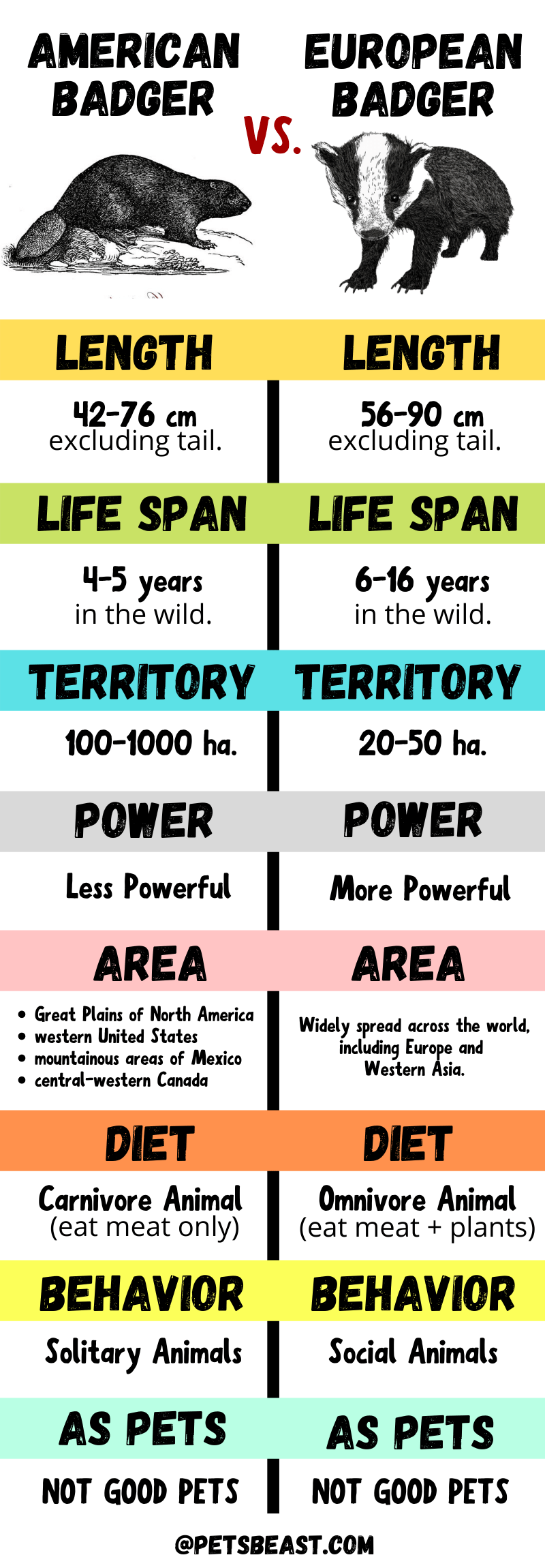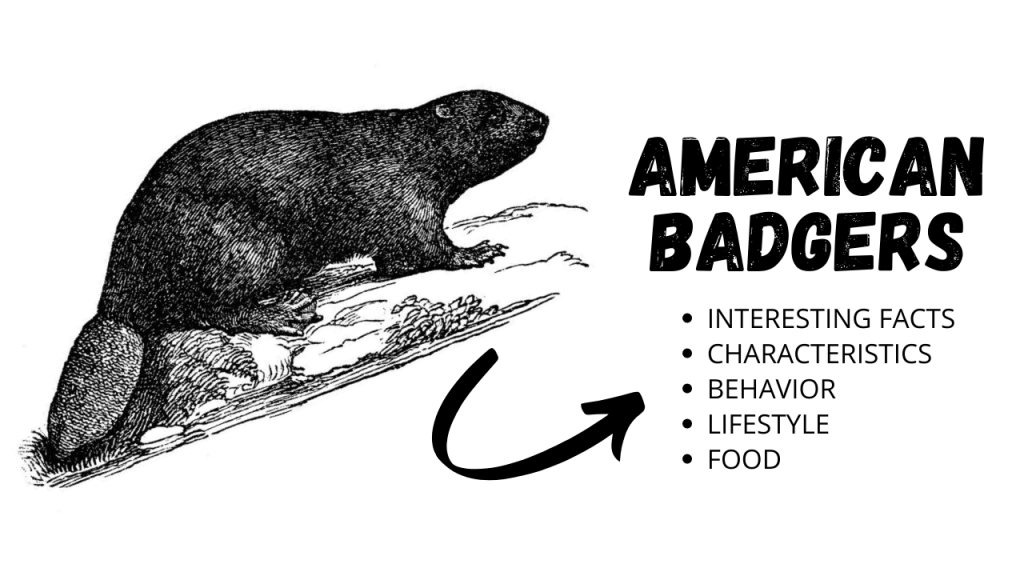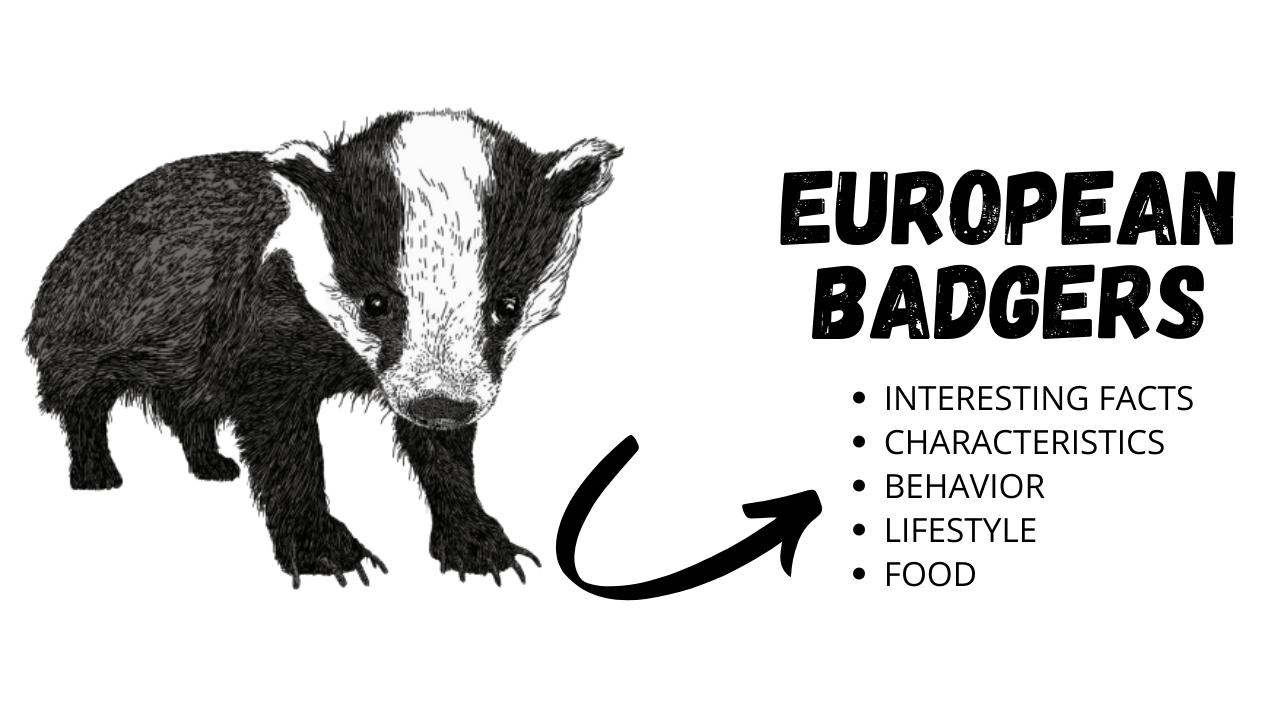What is an American Badger?
American Badger is a small-statured animal that has a flat body with short legs, a triangular face, and a long tipped-up nose. American Badger belongs to Mustelidae, the largest family of carnivores. The American badger has long, thick black or brown fur with white stripes on it that runs from its nose to the back of its head. It has long sharp claws and teeth, which helps them to catch their prey. American badgers are usually found in the United States, Columbia, Manitoba, Albert, Saskatchewan, and in southern Canada.
They usually survive on rats, ground squirrels, mice, gophers, snakes, and birds. Furthermore, in terms of predators – American Badger is well protected due to its muscular, thick loose fur that makes them harder to catch.
Read: American Badger Complete Information + Interesting Facts
What is a Eurasian Badger?
The European Badger is a medium-sized omnivorous mammal that has a powerful body structure with a short tail and solid limbs. The European badger is a member of the Mustelid family and is found in northeast India to central China and Southeast Asia where they consume mostly insects, worms, small birds, rodents, and wild fruits.
European badgers have dark stripes running from their nose to the eyes and ears and separated by a white stripe in the middle.
Read: European Badger Complete Information + Interesting Facts
American Badger Vs European Badger

Size Differences
The American badger is usually smaller in size than a European badger. American Badger is 23 cm (9 inches) tall and 42-76 cm long, excluding the 10-16 cm tail and it weighs about 4 to 12 Kg (9-26 pounds).
European Badger, on the other hand, is larger than the American badger. The European badger is 31 cm tall and 56-90 cm long, excluding the 12-20 cm tail and weighs 10-12 kg.
Life Span Differences
The American badger lives an average of 4-5 years in the wild.
While European badgers live an average of 6-16 years.
Territory Differences
American Badger home ranges are from 100 to 1000 hectares (1 to 10 square km ), depending on habitat and food resources.
European Badger territory ranges are from 20 to 50 hectares (0.2 to 0.5 km).
Power Differences
As a European badger is larger in size, so it’s obvious that the European badger is stronger than the American Badger. But still, there’s no proof that whether American badgers are stronger or European.
Area Distribution Differences
American Badgers are found primarily in the Great Plains of North America. They occur in the western United States, ranging southward through mountainous areas of Mexico and northward through central-western Canadian provinces. They are found in a wide range of altitudes, from alpine meadows to below sea level in Death Valley.
European Badgers are more widely spread across the world. They are mostly found in Europe (excluding North Scandinavia, Iceland, Corsica, Sardinia, and Sicily) and western Asia as far east as China. The area of their distribution is Albania, Armenia, Austria, Azerbaijan, Belgium, Bosnia and Herzegovina, Bulgaria, Croatia, Czech Republic, Denmark, Egypt, Estonia, Finland, France, Georgia, Germany, Greece, Hungary, Iran, Iraq, Ireland, Israel, Italy, Jordan, Kyrgyzstan, Latvia, Lebanon, Lithuania, Luxembourg, Macedonia, Moldova, Montenegro, Netherlands, Norway, Poland, Portugal, Romania, Russia, Serbia, Slovakia, Slovenia, Spain, Sweden, Switzerland, Syria, Turkey, Turkmenistan, Ukraine, United Kingdom, Uzbekistan, and Pakistan.
Diet Differences
American badgers are carnivorous, so they only eat meat. They eat a variety of small animals, insects, reptiles, mammals, birds, ground squirrels, moles, marmots, woodrats, prairie dogs, kangaroo rats, voles, deer mice, lizards, and snakes.
European badgers are omnivores, which means they consume both animals and plants. Their diet includes – lizards, snakes, fruits, earthworms, cereals, rabbits, insects, plant roots, eggs as well as carrion.
Behavior Differences
There are no any major behavior differences between the American and European badger, as both of these badger breeds usually get active at night, in search of their prey.
The only major difference between them is their friendliness:
- European badgers, being on the more friendly side, live in colonies of 6 to 20 badgers – comprising multiple males, non-breeding and breeding females, and baby badgers.
- American Badgers, on the other hand, are solitary animals and prefer spending most of their time alone. Their typical population density is about 5 animals per square kilometer.
Their powerful forelimbs allow them to tunnel rapidly through the soil and other substrates and spend most of their winters under this soil in their setts.
They are not true hibernators but spend much of the winter in cycles of torpor that usually last about 29 hours.
Young badgers are conceived in spring and stay with their mom until pre-fall. Once grown, the baby badgers move far away from their mom’s range to set up their own home range in a different territory. This is a perilous time for the baby badgers, as many of them are killed or harmed when going to far-flung areas.
European Badger vs American Badger: Who Will Win?
European Badger, though large in size and more powerful, is predicted to lose its fight against an American Badger. This is because American Badgers are more aggressive and violent-tempered than European Badgers. However, the most powerful and aggressive of the badger species is the Honey Badger which can even fight with a lion!









